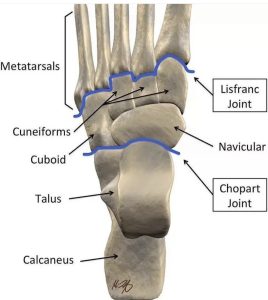 1176
1176
Anatomy of the Foot
Each foot is made up of 28 bones, 30 joints and more than 100 muscles, tendons and ligaments.
The foots parts work together to provide support, balance and mobility.
Nearly one-fourth of the body’s bones are in the feet.
The bones of the foot include:
Talus – it is on top of the foot that forms a joint with the two bones of the lower leg, the tibia and fibula.
Calcaneus – the largest bone of the foot, which lies beneath the talus and forms the heel bone.
Tarsals – there are five irregularly shaped bones of the midfoot that form the foot’s arch.
The tarsal bones are the cuboid, navicular and medial, intermediate and lateral cuneiforms.
Metatarsals – five bones make up the forefoot.
Phalanges-14 bones that make up the toes.
The big toe has of two phalanges, distal and proximal.
The remaining toes have three phalanges.
Sesamoid bones are 2 pea-shaped bones that lie beneath the head of the first metatarsal in the ball of the foot.
Except for the big toe, each of the toes has three joints, which include:
metatarsophalangeal joint (MCP)
proximal interphalangeal joint (PIP) – the joint in the middle of the toe
distal phalangeal joint (DP) – the joint closest to the tip of the toe.
The big toe has two joints: metatarsophalangeal joint
interphalangeal joint.
Where the bones join to form joints their surfaces are covered with a layer of cartilage, allowing them to glide.
The joints are enclosed by a fibrous capsule that is lined with synovium membrane which secretes a fluid to lubricate the joints.
There are twenty muscles giving the foot its shape, support and tthe ability to move.
The main muscles of the foot are:
the tibilias posterior, which supports the foot’s arch
the tibilias anterior, which allows the foot to move upward
the tibilias peroneal, which controls movement on the outside of the ankle
the extensors, which help raise the toes, making it possible to take a step
the flexors, which help stabilize the toes.
Tendons attach the above muscles to the bones.
Ligaments hold the bones together to maintain the foot’s arch.
The Achilles tendon is the major tendon of the foot.
The Achilles tendon runs from the calf muscle to the heel, and makes it possible to run, jump, climb stairs and stand.
The foot’s major ligaments are:
Plantar fascia – the longest ligament of the foot, running along the sole of the foot, from the heel to the toes, forming the arch.
Plantar calcaneonavicular ligament-ligament of the sole of the foot that connects the calcaneus and and navicular and supports the head of the talus.
calcaneocuboid ligament –connects the calcaneus and the tarsal bones and helps the plantar fascia support the arch of the foot.
The plantar fascia helps with balance and gives the foot strength for walking as it stretches and contracts.
With aging there is a loss of elastin and collagen fibers which can cause hard, dry skin on the plantar surface.
Hyperkeratosis is a common process in older adults.
Age related changes in the foot muscle, joints, and soft tissues and posture occur and may impair mobility.
With aging there is often a change in the size and shape of the foot that may affect the fit of shoes.
With age the foot becomes broader.
Ill-fitting footwear is prevalent in older adults and is associated with hyperkeratosis, foot pain, and deformities as well as amputation in patients with diabetes.
Older patients are more likely to have conditions associated with foot pathology: diabetes, peripheral arterial, disease, and neuropathy.
Patients with foot problems or more likely to have impaired functional status, and mobility, and falls.
Suboptimal foot care can lead to decline mobility and physical activity and may indicate difficulties in managing one’s own healthcare.
Poor foot care can lead to weight gain, joint pain, falls, reduced cardiovascular fitness and potentially increase the risk of frailty, impaired functional status, and poor performance in balance assessments.
Adequate foot care is important for maintaining health.
Undetected and untreated, foot ulcers may result in amputation or death.
There is a well describe relationship between foot disorders and falls, and gait disorders.
Older adults who have falls are more likely to experience foot pain and bony deformities.
Individuals with foot problems, more likely to have impaired functional status and mobility.
Suboptimal foot care can lead to declining mobility and physical activity, and may portend future difficulties with managing one’s health care.
Suboptimal foot care can contribute to weight gain, joint pain, falls, reduce cardiovascular function, and potentially result in increased risk of frailty, impaired functional status, and poor performance in balance.
Cutting toenails requires the ability to bend over, visual acuity and fine motor skills.
Community dwelling adults are found between 30 and 77% to have difficulty cutting their own toenails.
In patients 65 years and older almost 75% have a nail disorder.
A study of 100 hospitalized older adults found 89% could not cut their own toenails and 12% and visible dirt between their toes.
